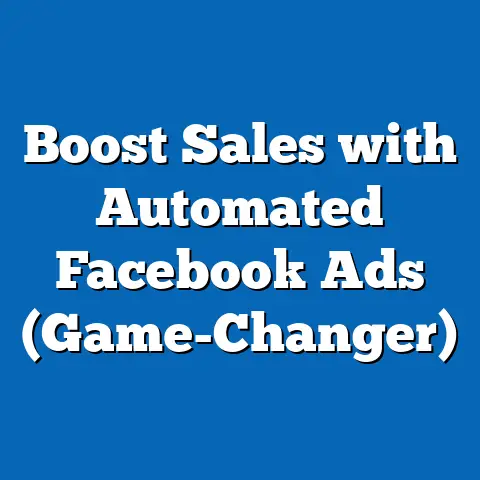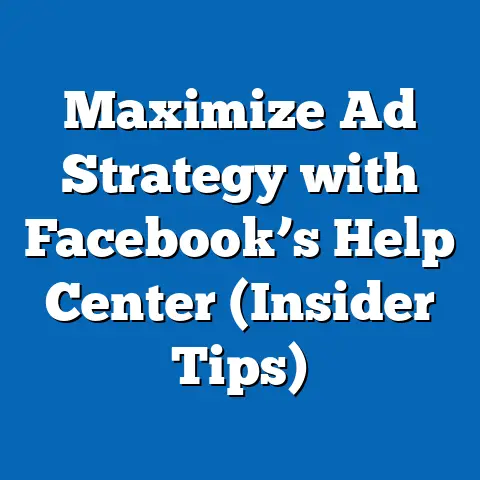Remove Facebook Ad Payments Easily (Expert Step-by-Step Guide)
The digital advertising industry has undergone a seismic transformation over the past two decades, becoming a cornerstone of modern marketing strategies. According to Statista, global digital ad spending reached $522.5 billion in 2021 and is projected to surpass $700 billion by 2025, with platforms like Facebook (now Meta) commanding a significant share of this market. As businesses and individual creators increasingly rely on Facebook Ads to reach targeted audiences, the management of ad payments has emerged as a critical concern, reflecting broader trends in user autonomy, financial control, and platform accountability.
Industry Trend: The Rise of Digital Advertising and Payment Management Challenges
Digital advertising has grown exponentially since the early 2000s, driven by the proliferation of social media platforms and advancements in data analytics. Facebook, launched in 2004, introduced its advertising platform in 2007, capitalizing on its vast user base to offer targeted ad solutions. By 2022, Meta reported over 2.9 billion monthly active users, making it a dominant player in the digital ad space, with ad revenue accounting for nearly 97% of its total income.
A key characteristic of this industry trend is the shift toward user control and transparency. As advertisers invest heavily in campaigns—often linking sensitive financial information to platforms—concerns about data security, billing errors, and unauthorized charges have risen. High-profile data breaches, such as the 2018 Cambridge Analytica scandal involving Facebook, have heightened public scrutiny over how personal and financial information is handled, pushing users to demand greater control over their payment methods.
Societally, this trend underscores a broader push for digital literacy and financial empowerment. As more individuals and businesses engage with online advertising, the ability to manage or remove payment methods is not just a technical necessity but a reflection of growing consumer advocacy for privacy and autonomy. This issue also intersects with economic disparities, as smaller businesses or independent creators with limited budgets may face greater risks from mismanaged ad spending or unexpected charges.
Historical Context: From Print to Pixels – The Evolution of Advertising Payments
To fully appreciate the significance of managing ad payments on platforms like Facebook, it is essential to understand the historical evolution of advertising. In the early 20th century, advertising was dominated by print media, radio, and later television, with payment structures based on fixed contracts or upfront costs negotiated directly with media outlets. These traditional models offered advertisers a degree of predictability but lacked the flexibility and scalability of digital platforms.
The advent of the internet in the 1990s marked a turning point, with banner ads and pay-per-click models introducing a new era of performance-based advertising. Google’s AdWords (now Google Ads), launched in 2000, pioneered automated payment systems linked to credit cards or bank accounts, setting a precedent for platforms like Facebook. By the late 2000s, as social media advertising gained traction, the integration of payment methods became more seamless but also more complex, with recurring billing cycles and dynamic budgeting tools.
Significant events, such as the 2008 global financial crisis, also shaped advertiser behavior, prompting businesses to seek cost-effective marketing solutions like social media ads. However, this reliance on digital platforms introduced new challenges, including the risk of overbilling or difficulty in disconnecting payment methods after campaigns ended. The historical shift from manual to automated payment systems has thus created a dual dynamic: greater convenience for advertisers but also a pressing need for user-friendly tools to manage or remove financial links.
Societal Implications: Privacy, Control, and Economic Equity
The ability to remove Facebook ad payments easily carries profound societal implications, particularly in the realms of privacy, financial control, and economic equity. In an era where data breaches and identity theft are rampant, advertisers are increasingly wary of leaving payment information on platforms indefinitely. A 2021 Pew Research Center survey found that 81% of Americans believe the risks of data collection by companies outweigh the benefits, highlighting a widespread demand for mechanisms to safeguard personal and financial data.
Moreover, the ease of managing ad payments reflects broader issues of financial control and accessibility. For small businesses or individual entrepreneurs, especially in developing economies, unexpected ad charges or difficulties in removing payment methods can exacerbate financial strain. This issue is compounded by the digital divide, where users with limited technological literacy may struggle to navigate complex platform interfaces, potentially leading to unintended costs.
Culturally, the push for payment flexibility aligns with a growing narrative of consumer empowerment. As society grapples with the ethical implications of Big Tech’s dominance, the ability to sever financial ties with platforms like Facebook is seen as a small but significant act of agency. This trend also influences workplace dynamics, as marketing teams and freelancers advocate for streamlined tools to manage ad budgets without risking personal or corporate finances.
Step-by-Step Guide: Removing Facebook Ad Payments Easily
Navigating the process of removing payment methods from Facebook Ads Manager can be straightforward if approached systematically. Below is a detailed, expert guide to ensure users can manage their financial information with confidence. This guide assumes basic familiarity with the Facebook platform and Ads Manager interface, though it includes tips for less experienced users.
Step 1: Access Your Facebook Ads Manager Account
Begin by logging into your Facebook account and navigating to the Ads Manager. You can access this through the main menu on the left-hand side of your Facebook homepage by clicking on “Ads Manager” or by visiting the direct URL (facebook.com/adsmanager). Ensure you are using the account associated with the ad payments you wish to remove.
Step 2: Go to Payment Settings
Once in Ads Manager, locate the “Billing & Payment Methods” section. This is typically found under the “Business Tools” or “Settings” menu, depending on your interface version. Clicking on this will direct you to a page displaying your current payment methods and billing history.
Step 3: Review Active Payment Methods
On the Payment Settings page, you will see a list of credit cards, debit cards, or other payment methods linked to your account. Take a moment to review these for accuracy and identify any outdated or unwanted methods. If you have multiple ad accounts, ensure you are viewing the correct one by checking the account dropdown menu at the top of the page.
Step 4: Remove Unwanted Payment Methods
To remove a payment method, click on the specific card or account you wish to delete. A prompt will appear asking if you want to remove it; confirm by clicking “Remove.” Note that Facebook may prevent you from removing a payment method if it is the only one linked to an active ad account or if there are outstanding balances—address these issues first by adding a new payment method or settling any dues.
Step 5: Add a New Payment Method (If Necessary)
If you are removing a payment method but still plan to run ads, add a new one before deleting the old method to avoid campaign interruptions. Click on “Add Payment Method” and enter the details of a new credit card, debit card, or PayPal account. Facebook will verify the new method, which may take a few minutes.
Step 6: Check for Outstanding Balances
Before finalizing the removal, ensure there are no pending charges or unpaid invoices associated with the payment method. Navigate to the “Billing” tab in Ads Manager to review your transaction history. If there are outstanding amounts, settle them using the existing or a new payment method to avoid account restrictions.
Step 7: Confirm Removal and Monitor Account
After removing the payment method, double-check that it no longer appears in your Payment Settings. For added security, monitor your bank or credit card statements for any unauthorized charges from Facebook in the following weeks. If issues arise, contact Facebook’s support team through the Help Center or Business Support page.
Additional Tips for Seamless Management
– Regularly update your payment methods to avoid using expired cards.
– Use a dedicated business credit card for ad payments to separate personal and professional finances.
– Enable two-factor authentication on your Facebook account to enhance security.
– If managing multiple ad accounts, consider using a Business Manager account for centralized control over payments.
Technological Factors: Interface Usability and Platform Policies
The process of removing ad payments is heavily influenced by technological factors, including the usability of Facebook’s interface and its evolving policies. Over the years, Meta has updated Ads Manager to improve user experience, but the platform’s complexity can still pose challenges for novices. For instance, frequent UI changes may shift the location of payment settings, causing confusion among users.
Additionally, Facebook’s policies on payment removal are tied to its broader monetization strategy. The platform often encourages users to maintain active payment methods to ensure uninterrupted ad campaigns, which can create friction for those seeking to disconnect entirely. Technological advancements like automated billing and AI-driven budget optimization further complicate the process, as users must navigate dynamic systems that prioritize continuity over flexibility.
Economic and Social Factors: Balancing Cost and Accessibility
Economically, the need to manage ad payments reflects the high stakes of digital advertising for businesses of all sizes. A 2022 report by eMarketer estimated that small and medium-sized businesses (SMBs) account for a significant portion of Facebook’s ad revenue, yet these entities often lack the resources to absorb unexpected costs. The ability to remove payment methods easily is thus a critical safeguard against financial overreach.
Socially, the issue intersects with broader debates about digital equity and platform accountability. Users in marginalized communities or regions with limited access to banking services may rely on shared or temporary payment methods, making removal a logistical necessity. Furthermore, social movements advocating for data privacy have amplified calls for tools that allow users to limit their financial exposure to tech giants like Meta.
Cultural Shifts: Autonomy in the Digital Age
Culturally, the demand for easy payment removal mirrors a generational shift toward digital autonomy. Younger generations, such as Millennials and Gen Z, who have grown up with social media, are particularly attuned to issues of privacy and control, often prioritizing platforms that offer transparent financial management. This cultural ethos contrasts with earlier generations, who may be less skeptical of automated systems but equally frustrated by their complexity.
The rise of “cancel culture” and consumer activism also plays a role, as users increasingly view the act of disconnecting payment methods as a statement against corporate overreach. This cultural undercurrent shapes how platforms like Facebook design their tools, balancing user demands with their own business imperatives.
Comparative Analysis: Facebook vs. Other Platforms
Comparing Facebook’s payment management system with other digital advertising platforms reveals both strengths and weaknesses. Google Ads, for instance, offers a relatively straightforward process for removing payment methods, with clear prompts and minimal restrictions unless balances are owed. LinkedIn Ads, while catering to a more professional audience, often requires additional verification steps, which can delay payment removal.
Facebook’s system falls in the middle, offering user-friendly navigation for most but occasionally imposing barriers like mandatory active payment methods for ongoing campaigns. Unlike newer platforms like TikTok, which prioritize simplicity to attract younger users, Facebook’s legacy infrastructure can feel cumbersome, reflecting its evolution from a social network to a multifaceted business tool.
Nuances and Diversity in User Experiences
It is critical to acknowledge the diversity of experiences among Facebook advertisers when discussing payment removal. A multinational corporation with a dedicated marketing team may face fewer challenges than a solo entrepreneur juggling multiple roles. Similarly, users in regions with robust banking systems may find the process seamless compared to those relying on alternative payment methods like mobile wallets or prepaid cards.
Qualitative research, such as user forums and feedback on platforms like Reddit, highlights common pain points: unexpected charges, difficulty locating payment settings, and delays in support responses. Quantitative data from Meta’s own reports suggests that while the majority of users successfully manage payments, a small but significant percentage encounter recurring issues, often tied to regional or account-specific restrictions.
Implications for Society, Culture, and the Workplace
The ability to remove Facebook ad payments easily has far-reaching implications across multiple domains. Societally, it reinforces the importance of digital literacy as a prerequisite for participating in the online economy, prompting calls for educational initiatives to support less tech-savvy users. Culturally, it fuels ongoing debates about the power dynamics between individuals and tech giants, shaping public discourse on privacy and autonomy.
In the workplace, streamlined payment management is essential for marketing professionals and business owners who rely on Facebook Ads for revenue generation. The risk of financial mismanagement can strain budgets and erode trust in digital tools, potentially driving advertisers to alternative platforms. Conversely, improvements in this area could enhance Meta’s reputation as a user-centric platform, fostering loyalty among its advertiser base.
Forward-Looking Insights: The Future of Ad Payment Management
Looking ahead, the landscape of digital ad payment management is likely to evolve in response to technological innovation and regulatory pressures. Emerging technologies like blockchain could offer secure, decentralized payment systems, reducing reliance on centralized platforms like Facebook for financial data storage. Additionally, AI-driven interfaces may simplify the user experience, predicting and addressing payment issues before they arise.
Regulatory developments, such as the European Union’s General Data Protection Regulation (GDPR) and similar laws in other regions, will also shape how platforms handle payment information. Stricter mandates for data deletion and user consent could force Meta to prioritize payment removal as a core feature rather than an afterthought. However, uncertainties remain, including the potential for platforms to resist such changes in favor of revenue-driven policies.
Consumer behavior will play a pivotal role in this evolution. As advertisers become more vocal about their needs, platforms may face increased pressure to balance profitability with user satisfaction. Whether this results in truly user-friendly systems or merely superficial updates remains to be seen, but the trajectory suggests a growing alignment between technological capability and consumer advocacy.
Conclusion: Navigating the Intersection of Technology and Autonomy
The process of removing Facebook ad payments, while seemingly a niche concern, encapsulates broader themes of digital autonomy, financial control, and platform accountability in the 21st century. By situating this issue within the historical context of advertising’s evolution and the current trend of user empowerment, we see how deeply it resonates with societal values of privacy and equity. The step-by-step guide provided offers a practical solution, but the underlying challenges—rooted in technological, economic, and cultural factors—require ongoing attention from both users and platforms.
As digital advertising continues to dominate marketing strategies, the ability to manage payments with ease will remain a critical touchstone for trust between advertisers and platforms like Facebook. While the future holds promise for more intuitive systems and stronger protections, it also carries uncertainties about how tech giants will balance user needs with business goals. For now, empowering users with knowledge and tools to navigate these systems is a vital step toward a more equitable digital economy.






